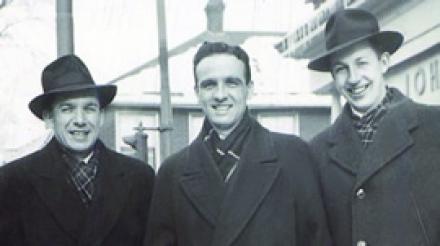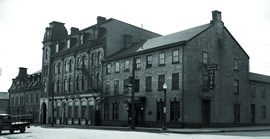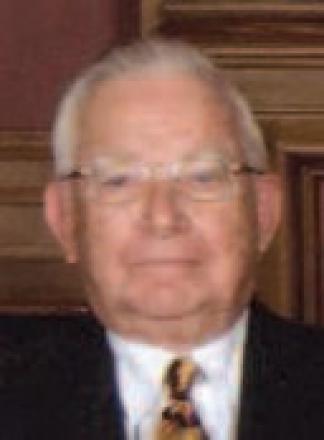The Forties: Fighting Over and futures bright
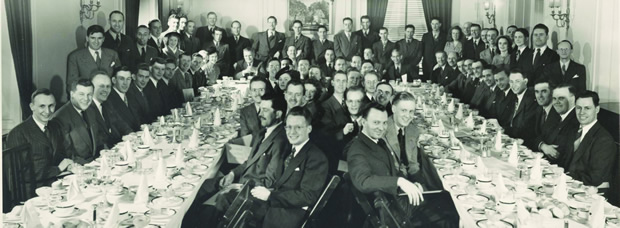
Made up almost exclusively of World War II veterans, the class that enrolled in 1944 was ready to put the past behind them and take advantage of all that life had to offer.
“We were very anxious to learn. The professors loved us because we were like sponges. We soaked up information quickly and felt very fortunate to be here,” says John Purkis, one of the 79 students, including five women, who would graduate from the Commerce Program in 1948.
This was a class that took nothing for granted. “I would say that 90 per cent of us wouldn’t have had the chance to attend university without the veteran credits that could be applied towards housing or education,” he says.
Those who chose university received tuition plus a living allowance of $60 monthly for a single person, $90 for a married couple, plus $15 per child. Some felt the amounts inadequate, but an on-campus meeting resulted in a consensus that the funding was fair. Initially, payments were calculated at a rate of one month’s credit for each month of service, but this was subsequently relaxed in such a way that support would continue even for post-graduate studies, as long as the veterans kept up their grades.
“In those years, the ratio of men to women was five to one,” recalls Gerald Sutton, BCom’48, MCom’49. “Dates were hard to get, but the nurses at Kingston General Hospital helped out,” he recalls.
After John completed his war service (which included work as an accountant), he consulted his brother-in-law about where to go to university. “He said if I wanted to just sit and listen to lectures I should go to Toronto, and if I wanted to get to know my professors I should go to Queen’s. I liked the size of Queen’s and that it was very social. As it turned out, our professors spent time with us outside the classroom and many became lifelong friends.”
The many professors of the era who are still celebrated by the Queen’s community and beyond for their exemplary leadership include L.G. Macpherson, F.A. Knox, J.A. Corry, R.G.H. Smails and W.A. Mackintosh. John fondly remembers Prof. Lorne McDougall, an expert in the building of the Canadian Pacific Railway, “who never gave a lecture without some reference to the railroad. Lorne was Honorary President of Comm‘48 until his death.” Equally memorable was the frenetic statistics professor, G.L. Edgett, affectionately nicknamed “Edgett the Fidget,” who “covered the blackboard with numbers from front to back and left our class bewildered.”
 When Professor Smails authored a textbook – the first Canadian standard text in accounting, which was used well into the 1950s – the class played a significant role. “As he was writing it, he would bring each chapter to class and we would help to proofread it and do the tests that were part of each section,” John says.
When Professor Smails authored a textbook – the first Canadian standard text in accounting, which was used well into the 1950s – the class played a significant role. “As he was writing it, he would bring each chapter to class and we would help to proofread it and do the tests that were part of each section,” John says.
The veterans’ maturity and wartime experiences meant the dynamics of the program underwent a not-so-subtle shift. Some of the veterans had been through a lot and had faced death more than once. The sophomores, many of whom were considerably younger than the incoming frosh, backed down from subjecting this group of vets to the Orientation rites that had long been a Queen’s tradition. A compromise was put forward to have the frosh serve the sophomores dinner. The frosh countered with a proposal to host a dinner for the following year’s freshmen class. Both sides agreed, and a new tradition was born.
“We were so confident. The war was over, and the world was our oyster.”
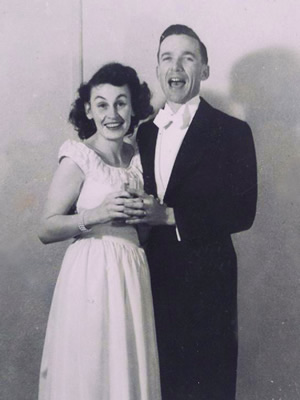 John and Eunice Purkis at the Arts Formal Until the School of Business became a separate faculty in 1963, the Commerce program resided in the Faculty of Arts. During John’s time, the focus was mainly on economics, commercial law, marketing, banking and finance, and classes were held in the new Arts Building (Kingston Hall).
John and Eunice Purkis at the Arts Formal Until the School of Business became a separate faculty in 1963, the Commerce program resided in the Faculty of Arts. During John’s time, the focus was mainly on economics, commercial law, marketing, banking and finance, and classes were held in the new Arts Building (Kingston Hall).
In those days, no alcohol was served on campus. Students routinely headed downtown to the BA (British American) Hotel on Clarence Street after receiving their monthly cheques. After paying the landlady ($4 per week rent usually) and meals ($1 a day), plus supplies, there was only enough left over for one party a month. Another favourite haunt was the original Queen’s Tea Room at the corner of Union and Division (now the site of a trendy new tea room in Beamish-Munro Hall). At one point, some classmates contemplated buying out the old house with its upstairs banquet hall and running the Tea Room themselves – a pipedream, as it turned out. Another cause was fundraising to help support the family of a classmate who was sent to jail for robbery.
Classmate Helen Bronskill remembers her days in Commerce as supremely happy ones. “We were so confident. The war was over, the world was our oyster, and everyone was going to be alright. It was a very exciting time.”
She enjoyed her classes and found nothing uncomfortable about being one of so few women. It was only when job-hunting after graduation that she learned she would have to play second-fiddle to male job-seekers. On more than one occasion, she was explicitly told that her gender was an issue in denying her a job or that her status as a married woman was cause for terminating her employment. Three of the women of the class of 1948 married classmates: Helen (Armstrong) to Eric Bronskill; Glenna (Julian) to Roly Lorimer, and Marg (Slorance) to David Osborn.
As Class President, John Purkis keeps track of his classmates and estimates that 25 of them are still living, eight of them having returned with their spouses for the fall 2008 reunion. Commerce ’48 has become well known for its sense of fun and spirit at Homecoming weekends. Class members have been known to parade around the football field at half-time wearing bowler hats and brandishing umbrellas emblazoned with the class crest. Those high spirits have gone hand-in-hand with an unfailing appreciation for life’s blessings and a desire to give back to Queen’s.
“90 per cent of us wouldn't have had the chance to attend university without the veteran credits.”
John recalls his classmate Gerald Sutton, former president of Canada’s first venture capital company, as being one of the strongest advocates of the entrance scholarship that the class established at its 50th reunion. Gerald and his wife Margaret (Scally, BA’48) have also been long-time supporters of the School, contributing privately towards bursaries and scholarships. The Gerald and Margaret Sutton Graduate Studies Seminar Room in Goodes Hall recognizes their generosity.
The Commerce’48 Entrance Award was established in recognition of the financial support provided by the Government to veterans attending universities, and also “in memory of those who might have been classmates had they not died in the war.” Gerald penned a poem that captured the class’s sentiments:
“In memory of those who, had they returned alive
From war, might then have come to Queen's.
Leaders of men newfound, some still within their teens,
From those whom fortune favoured to survive.”
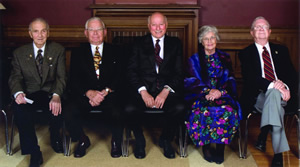
The fund provides over $5,000 per year to students in financial need entering their first year of Commerce and it is expected that it will grow to provide over $12,000 per year due to the generous estate planning of these QSB alums.
When the remaining members of the Class of ‘48 congregate at Queen’s reunions now, it is a bittersweet time. There are fewer old classmates with whom to reminisce, but the remaining friendships only grow deeper.

